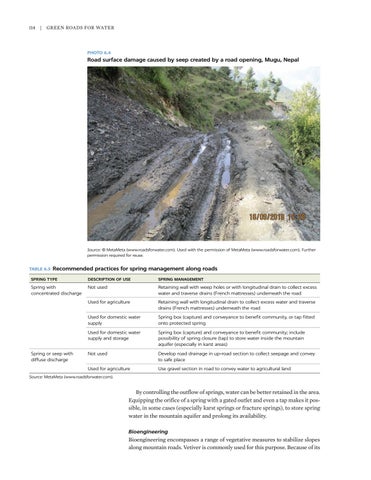114 | Green Roads for Water
PHOTO 6.4
Road surface damage caused by seep created by a road opening, Mugu, Nepal
Source: © MetaMeta (www.roadsforwater.com). Used with the permission of MetaMeta (www.roadsforwater.com). Further permission required for reuse.
TABLE 6.3 Recommended
practices for spring management along roads
SPRING TYPE
DESCRIPTION OF USE
SPRING MANAGEMENT
Spring with concentrated discharge
Not used
Retaining wall with weep holes or with longitudinal drain to collect excess water and traverse drains (French mattresses) underneath the road
Used for agriculture
Retaining wall with longitudinal drain to collect excess water and traverse drains (French mattresses) underneath the road
Used for domestic water supply
Spring box (capture) and conveyance to benefit community, or tap fitted onto protected spring
Used for domestic water supply and storage
Spring box (capture) and conveyance to benefit community; include possibility of spring closure (tap) to store water inside the mountain aquifer (especially in karst areas)
Not used
Develop road drainage in up-road section to collect seepage and convey to safe place
Used for agriculture
Use gravel section in road to convey water to agricultural land
Spring or seep with diffuse discharge
Source: MetaMeta (www.roadsforwater.com).
By controlling the outflow of springs, water can be better retained in the area. Equipping the orifice of a spring with a gated outlet and even a tap makes it possible, in some cases (especially karst springs or fracture springs), to store spring water in the mountain aquifer and prolong its availability. Bioengineering
Bioengineering encompasses a range of vegetative measures to stabilize slopes along mountain roads. Vetiver is commonly used for this purpose. Because of its







































